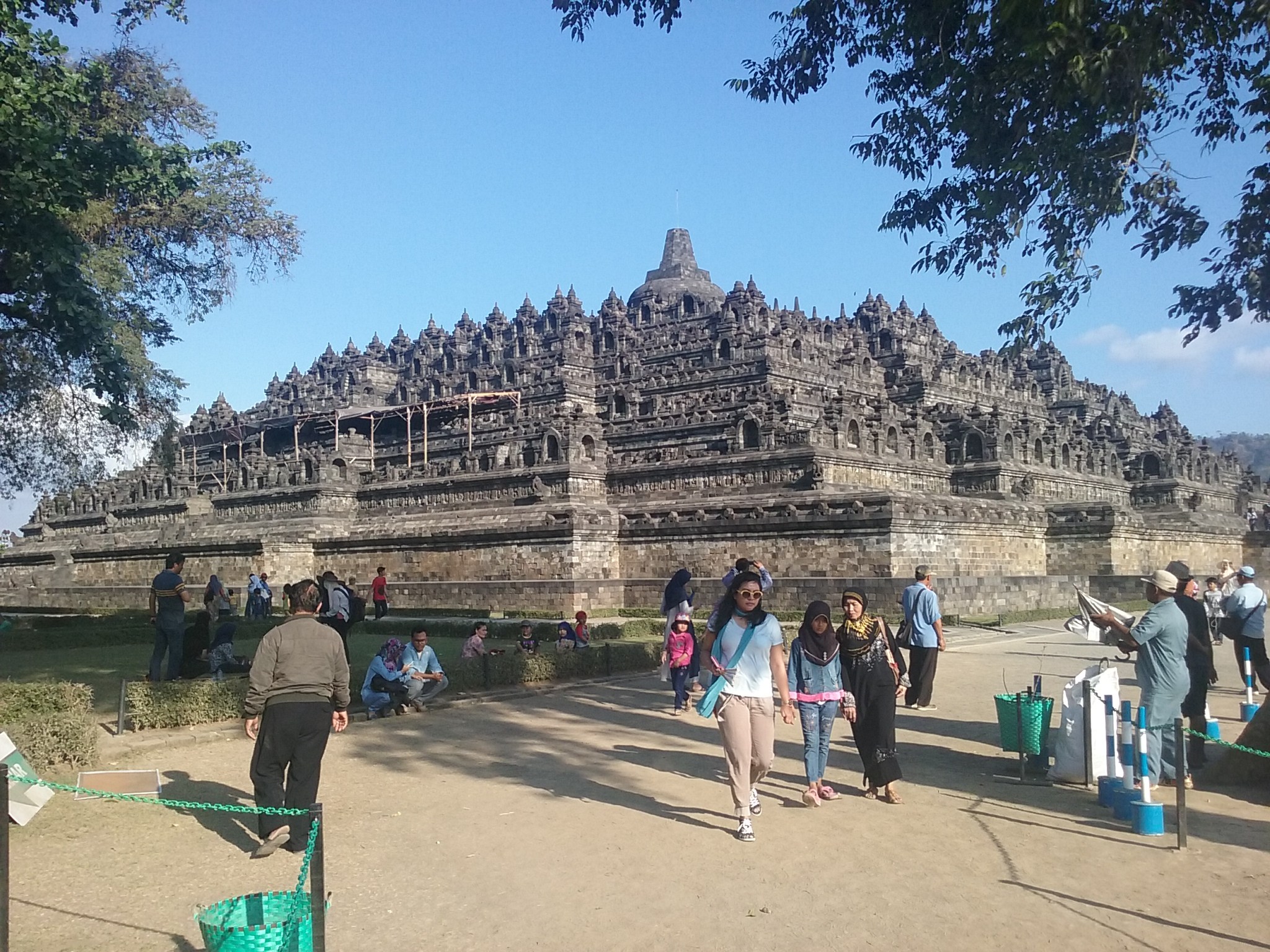

Borobodur, Indonesia 2015. Photo by Jeffrey Mellefont
Candi Borobodur, the great 8th-century Buddhist stupa in central Java, is rightly considered one of the wonders of the ancient world. With its backdrop the spectacular, active volcano Gunung Merapi, Borobodur is an hour and half drive from Yogyakarta where the ANMM exhibition Black Armada has just opened. (see curator Dr Stephen Gapps’ recent blogs about setting up and opening the exhibition).
When chairman of the ANMM Council, Peter Dexter AM, arrived in Yogyakarta after an intense schedule of meetings in Indonesia’s chaotic capital Jakarta, and with just a brief Sunday afternoon’s break before the official opening of Black Armada the following day, Borobodur was the absolute ‘must see’ priority. Not just Indonesia’s most iconic ancient site, it offers insights into the maritime significance of our archipelagic neighbour Indonesia, a significance as vital today as in the distant past.

Chairman of the ANMM Council, Peter Dexter pictured left with associates.
Borobodur rises from an extensive plain of irrigated rice fields, and it was the agricultural surpluses of these fertile volcanic soils that created wealth for the powerful early kingdoms of the archipelago. Kings of the Sailendra dynasty mobilised their populations to build Borobudur, and other nearby monuments, to reflect their own power and the glories of Hinduism and Buddhism.
These religions had arrived earlier in the first millennium AD with sea-borne traders from India and Sri Lanka, who were part of an ancient maritime trade route between China and the Indian Ocean. The Indonesian archipelago produced immensely valuable spices that fed into this trade in rare and exotic products, in which its ships played an active part. This, and the control of vital ports along the trade route, added to the wealth and power of its first kingdoms.

Chairman of ANMM Council Peter Dexter AM, inspects a relief carving of a ship at Borobudur. Photo by Jeffrey Mellefont
Uniquely, Borobodur provides us the only existing graphic record of that period’s shipping. Friezes carved into the walls of its many volcanic-stone galleries tell stories of the Buddha, kings and commoners, including realistically depicted artefacts from daily lives. I led chairman Peter Dexter and our party straight to the most famous and detailed ship depiction, of a galley that’s been interpreted as a warship or for regal or ceremonial use. That it’s neither Chinese, Indian or Middle-Eastern in origin is clear from its distinctive masts, sails, steering gear and outriggers. All are markers of this archipelago’s seagoing technologies, and indeed all can still be found on surviving traditional craft today.
We then made for a museum in the Borobodur heritage park, opened 10 years ago to house an impressive wooden replica of the 8th-century ship we saw in the frieze. In the early 2000s this replica, called Samudera Raksa, recreated ancient voyages to East Africa and Madagascar (populated about the first millennium AD by Indonesian voyagers) and on around the Cape of Good Hope to Dacca in West Africa where fascinating cultural similarities suggest possible connections too. The replica was designed by Australian Nick Burningham, the leading expert on Asian ships and replicas, who supervised its construction on a remote island in the Java sea by skilled Indonesian traditional shipwrights.
ANMM chairman Peter Dexter had flown to Jakarta direct from the August ANMM Council meeting for discussions with the Australian Ambassador Peter Grigson (who later joined us in Yogyakarta to open Black Armada), and other key consular staff. The topic was ANMM’s growing program of collaborations with Indonesian museums and archaeologists. A further day was spent in meetings with the heads of Indonesia’s impressive National Museum and Jakarta’s maritime museum, the latter housed in handsome, heritage-listed 18th-century warehouses built by the United Dutch East India Company (VOC) in old Batavia. My role was translating where necessary, and providing background briefings on various Indonesian matters.
With the meetings behind us we boarded a smart little cruiser to visit two historical islands on Jakarta Bay – part of an offshore archipelago called Pulau Seribu (‘Thousand Islands’). Our first destination was Pulau Onrust, a flat little coral cay of about 500 metres diameter that was the site of a very important shipyard for the VOC – the early multinational corporation that was empowered by The Netherlands to trade and rule in the East Indies, by force when necessary. Onrust’s busy island shipyard was defended by a fort and was healthier for its workers than Batavia city itself, notorious for diseases festering in the canals that the Dutch had created there.

VOC graveyard at Onrust. Photo by Jeffrey Mellefont
It was to Onrust that James Cook brought HMB Endeavour in 1770, after running onto coral on the Great Barrier Reef near today’s Cooktown, to make good the temporary repairs he’d undertaken on the Australian coast. In a tidy little museum on Onrust, established by the Jakarta City Government, we examined a diorama of the VOC shipyard, to see if today’s landing place in a small rectangular cove was the remnant of a graving dock that might have housed Endeavour. As we know, after running a famously healthy ship Cook lost many men to Batavia’s diseases during Endeavour’s stay.
Wandering the pleasant, park-like Onrust island in the shade of old trees, ample signage made it easy to trace the foundations of the fort, locate the old VOC graveyard and the remnants of the island’s other uses by the Dutch government once it had taken over from a bankrupt VOC, a few decades after Cook’s visit. This included a period in the early 20th century as a quarantine camp for ‘native’ Muslim pilgrims returning from the Haj, as the pilgrimage to Mecca is known.

Peter Dexter AM at the Bidadari Martello tower. Photo by Jeffrey Mellefont
But other than the museum, in the old quarantine hospital, little stands on Onrust except foundations. That’s because in 1883 it was wiped clean by the devastating tsunami that swept into Jakarta Bay after the cataclysmic eruption of Karakatau, just 150 kilometres to the west. The evidence for that was even more graphic on our next stop, the little resort island next door called Pulau Bidadari (Island of Angels). Here a massive Dutch Martello tower, built for defence in 1850, was sheared off by the same wave just a couple of metres up from its base.
Back onshore we made one final maritime heritage visit, to the traditional trading boat port of Sunda Kelapa within sight of the maritime museum. It’s where the inter-island trading fleet of timber prahus moors, in a long line of white timber hulls each with an identical dramatic sheerline sweeping upwards to a raking stem and tripod bowsprit. Still built of forest hardwoods by the maritime Bugis and Makassan clans, their residual masts and quarter steering oars recall the famous engineless pinisi sailing fleet from which they evolved just a few decades ago.
Next day we were off to Yogyakarta and Borobodur, before the opening of the museum’s first-ever exhibition and collaboration with an Indonesian museum, Museum Benteng Vredeberg, in the well-preserved Dutch fort built, again, by the VOC in the 18th century.
Black Armada is also on display at the Australian National Maritime Museum until 24 February 2016. Find out more about the fascinating history of the Black Armada through our digital story.


